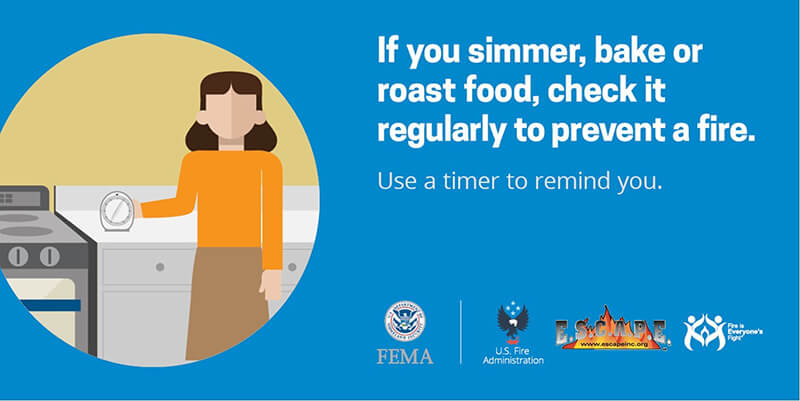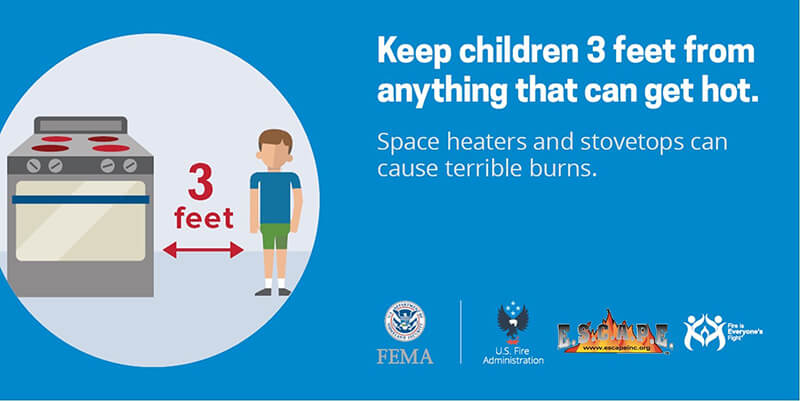Community Partners


Contact: Michael McLeieer, APIO, CFSI-III
President, E.S.C.A.P.E.
(269) 492-3340
Email: michael.mcLeieer@escapeinc.org
Website: www.escapeinc.org
Campaign: Cooking Up a Plan for Fire Safety
Details:
For many, the kitchen is the heart of the home and brings the family together. From being creative and cooking family recipes to decorating cakes and cookies, everyone enjoys being part of the preparations. However, no matter how experienced you are, fires in the kitchen happen when they are least expected.
That’s why this year’s Fire Prevention Week theme is Cooking safety starts with YOU. Pay attention to fire prevention.™ Fire Prevention Week 2023 is recognized October 8 – 14th .
According to the United States Fire Administration , cooking is the leading cause of home fires and fire injuries. And according to the National Fire Protection Association , fire departments in the United States responded to an estimated average of 170,000 home cooking fires in 2021. These fires caused an estimated 135 deaths, 3,000 injuries and over $494 million in property loss.
“To prevent cooking fires, you must be alert,” according to firefighter Michael McLeieer, president of the non-profit E.S.C.A.P.E. Fire Safety. “You will not be alert if you are sleepy, have consumed alcohol, or have taken medicine or drugs that make you drowsy,” says McLeieer.
As you start preparing your next meal and organizing that large family feast, remember to play it safe! E.S.C.A.P.E. Fire Safety and their partner First Alert offer a few simple tips so you can enjoy time with your loved ones and keep yourself and your family safer from fire.
Cook with Caution – Unattended cooking is the leading cause of home fires.
- An adult should remain in the kitchen when anyone is frying, boiling, grilling, or broiling food.
- Stay at home when simmering, baking or roasting food and check it regularly.
- Watch what you heat - Use a timer when cooking to help ensure you don’t lose track of the time. This is an especially important kitchen fire safety tip for beginner cooks.


Keep the Kitchen Free From Clutter
- Remove items that do not belong in the kitchen and avoid any additional fire hazards.
- Be mindful of kitchen materials that are flammable and can easily start fires such as oven mitts, wooden utensils, towels, curtains or even excess food packaging and keep them away from the stovetop or other cooking surface.
- Give everything a specific place in the kitchen to help reduce the risk of it being left out and catching fire, ensuring the kitchen remains a safe place.
Unplug or Turn Off Appliances
- Unplug any countertop appliances when they are not in use, like toasters and coffee makers. This will help reduce the risk of a fire starting.
- Turn off the appliance you are using as soon as you are finished cooking your food.
- Clean off leftover dust, food crumbs and grease from your stovetop after use.
Install and Maintain Smoke Alarms
Install smoke alarms in every sleeping room, outside each separate sleeping area and on every level of the home including in the basement.
- A closed door may slow the spread of smoke, heat and fire.
- Test smoke alarms at least once a month, replace 9-volt smoke alarm batteries at least once a year and replace alarms every 10-years.
- Larger homes may require additional smoke alarms to provide a minimum level of protection.
- Interconnect all smoke alarms throughout the home for best protection. When one alarm sounds, they all sound. When you hear a smoke alarm, you may have less than 2-minutes to get everyone outside and safe. Call 9-1-1 once outside and at the meeting place (tree, neighbor’s house, etc.).
- Make sure everyone can hear the sound of the smoke alarm anywhere in the home.
- For people who are deaf or hard of hearing, install smoke alarms with alert devices (pillow or bed shaker or a flashing strobe light).
- Install smoke alarms away from the kitchen to prevent nuisance alarms. They should be installed at least 10 feet from a cooking appliance.
Create a Kid-Free Zone Around Your Stove While Cooking
- Have a “kid-free zone” of at least 3 feet around the stove and areas where hot food or drink is prepared or carried.
- Never hold a child while you are cooking, drinking a hot liquid, or carrying hot foods or liquids.
- Keep pets off cooking surfaces and nearby countertops to prevent them from knocking things onto a burner.


Finally, turn pot handles toward the back of the stove so that no one can bump the pot or pull it over. Also, keep a pan lid or baking sheet nearby. Use it to cover the pan if it catches on fire. This will put the fire out. By following these safety tips , you will have a delicious and fire safe meal!
